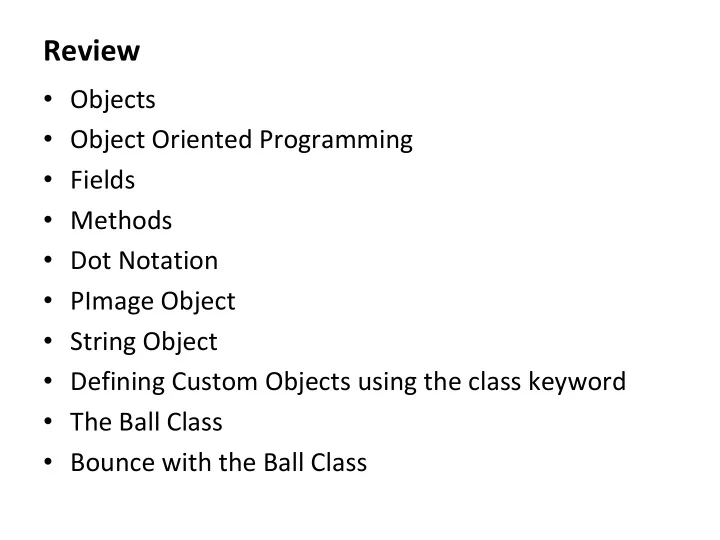

Review • Objects • Object Oriented Programming • Fields • Methods • Dot Notation • PImage Object • String Object • Defining Custom Objects using the class keyword • The Ball Class • Bounce with the Ball Class
Signature Polymorphism poly = many, morph = form • It is possible to define multiple functions with the same name, but different signatures. – A function signature is defined as • The function name, and • The order of variable types passed to the function • Consider the built- in color() function … color(gray) color(gray, alpha) color(value1, value2, value3) color(value1, value2, value3, alpha) …
Signature Polymorphism void draw() { } void mousePressed() { int i; i = 10; i = increment(i, 2); //i = increment(i); println(i); } // increment a variable int increment(int j, int delta) { In this case it is j = j + delta; said that the return j; increment function } is overloaded int increment(int k) { k = increment(k, 1); return k; }
Our Toolkit • Graphics – lines, shapes, images, text, color, … • Data of Various Types – Numbers (with and without decimal places) – Booleans (true, false) – Color (two color models) – Characters and Strings • Variables – Hold/name any type of data values • Arrays • Operators – Mathematical (+, *, ++, %, …) – Relational (<, >=, !=, ==, …) – Logical (&&, ||, !)
Our Toolkit (Continued) • Functions – Mathematical, Graphical, Utility, … – Of our own design • Expressions – Combine of data, variables, operators, functions • Conditionals – if-statements – switch-statement • Iterations – while-loop – for-loop • Data Structures – Arrays – Functions that manipulate arrays • Objects
Top-Down Design • At first blush, solving a hard problem can seem daunting – Create a clone of Adobe Photoshop – Create a new web browser • A common technique for solving complex problems is called Top-Down Design – a.k.a. "Step-wise Refinement" 1. Define a sequence of steps to solve a given problem at the highest, most abstract level. 2. Recursively, list a sequence of sub-steps to solve each higher-level step 3. Repeat until the sub-problem is "easy enough" to solve directly http://www.csee.umbc.edu/courses/undergraduate/CMSC104/fall06/burt/lectures/
Top-Down Design - Advantages • Promotes Organization – Your code is naturally organized, and easy to understand – Avoids the "spaghetti code" syndrome • Simplifies the Problem – The larger complex problem reduces to several smaller, more simple problems • Promotes Reuse – Several sub-problem solutions may be reusable by multiple parts of your program – Some sub-problems have existing solutions implemented • Enables Shared Development – Multiple people can work on different parts of the problem at the same time
Top-Down Design - Example Have Dinner 1. Cook Food 2. Set Table 3. Serve Food 4. Eat Food 5. Clean Up
Top-Down Design - Example Have Dinner 1. Cook Food 1. Boil Noodles 2. Stir-fry Veggies 3. Mix together 2. Set Table 3. Serve Food 4. Eat Food 5. Clean Up
Top-Down Design - Example Have Dinner 1. Cook Food 1. Boil Noodles 1. Boil water 2. Pour in dry noodles 3. Let cook 4. Strain noodles 2. Stir-fry Veggies 3. Mix 2. Set Table 3. Serve Food 4. Eat Food 5. Clean Up
Pop • A game that measures your balloon-popping skill. • How it should work… – As game runs, randomly placed balloons inflate – When the player pops (clicks on) a balloon, 1 point is earned – Points are added up throughout the game duration – If one click is over top multiple balloons, all balloons pop and multiple points are earned – The game runs for 30 seconds, and then ends
Recommend
More recommend